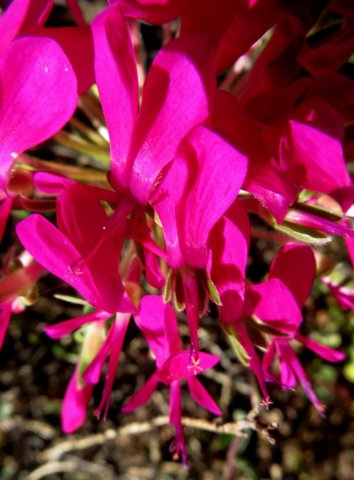Pelargonium incrassatum flowers

Author: Ivan Lätti
Photographer: Thabo Maphisa
The magenta to pink, cerise or cerise-purple flowers of Pelargonium incrassatum grow in a few umbels on long peduncles emerging from the base of the plant and displaying them above the leaves. An umbel may consist of 20 to 40 flowers.
Each flower has two large upper petals, closely together at the base, while sometimes veering sideways, away from each other from halfway up. The other three petals, the lower ones that complete the spreading, two-lipped corolla, are minuscule. Petals are not marked in darker colours, (as for instance the similarly coloured flowers of P. echinatum, also occurring in Namaqualand and another t'neitjie). The corolla of P. incrassatum has a diameter of about 2 cm and a tube of about 4 cm long.
The straight, petal-coloured filaments topped by small anthers cohere in a cluster, protruding well in front of the flexed back petal lobes. The five-pointed, white starlet that is the stigma is longer than the stamens, in front of the anthers.
Flowering coincides with the Namaqua peak season of late winter to early spring. Perennials like P. incrassatum match many of the flamboyant annuals in colour abundance. This is probably the number one Pelargonium of Namaqualand in blooming terms (Manning, 2009; Le Roux, et al, 2005; Eliovson, 1990; iNaturalist).

